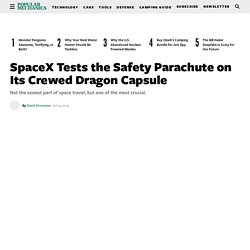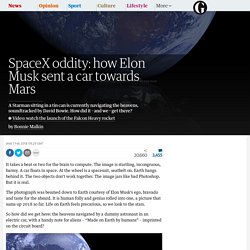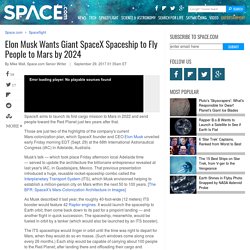

European CubeSat Symposium - Home. Orbital Micro Systems. SpaceX Tests the Safety Parachute on Its Crewed Dragon Capsule. Not many companies know how to make parachutes alluring, but most companies aren't SpaceX.

The California-based company has released a compilation video of its latest safety testing for its Crew Dragon parachute recovery system testing. In a comment along with the video, the California company says that it "is returning human spaceflight capabilities to the United States with one of the safest, most advanced systems ever built. " The Crew Dragon, which is meant to carry up to seven astronauts, has had its parachute system closely examined this year. In April 2019, Bill Gerstenmaier, then NASA Associate Administrator for Human Exploration and Operations, answering a question from by Alabama Congressman Morris Brooks during a House subcommittee hearing, told Brooks that a then-recent test of the Crew Dragon's parachute system “was not satisfactory.” Watch SpaceX Launch And Land The World's Most Powerful Rocket.
How SpaceX is changing the Space Industry. Gwynne Shotwell: SpaceX's plan to fly you across the globe in 30 minutes. Scatter ashes in space. Scattering Ashes - Stratosphere / Space: UK Wide - Scattering Ashes. Celestis: Memorial Spaceflights - Space Funeral Ashes Burial. Effective Date: May 25, 2018 Celestis, Inc.

("Celestis") is a subsidiary of Space Services Holdings, Inc., the commercial space pioneer whose memorial spaceflights have served hundreds from around the world. Celestis knows that you care how information about you is used and shared, and we appreciate your trust that we will do so carefully and sensibly. In this Privacy Statement, Celestis shall mean the Celestis Website managed by Space Services Holdings, Inc.
("we"), operating at www.celestis.com. This Privacy Policy explains what information of yours will be collected by Celestis when you access the site (including through the websites of our partners), how the information will be used, and how you can control the collection, correction and/or deletion of information. This Privacy Policy does not apply to information we collect by other means (including offline) or from other sources. Celestis respects the privacy of our customers. Information Collection And Use Third Party Cookies P.O. A 3D-printed rocket engine just launched a new era of space exploration. The rocket that blasted into space from New Zealand on May 25 was special.

Not only was it the first to launch from a private site, it was also the first to be powered by an engine made almost entirely using 3D printing. This might not make it the “first 3D-printed rocket in space” that some headlines described it as, but it does highlight how seriously this manufacturing technique is being taken by the space industry. Members of the team behind the Electron rocket at US company RocketLab say the engine was printed in 24 hours and provides efficiency and performance benefits over other systems.
There’s not yet much information out there regarding the exact details of the 3D-printed components. But it’s likely many of them have been designed to minimise weight while maintaining their structural performance, while other components may have been optimised to provide efficient fluid flow. In orbit Looking even further ahead, 3D printers could prove useful in building colonies. First Private Moon Landing Gears Up for Launch by Year's End. RemoveDEBRIS mission. RemoveDEBRIS platform The RemoveDEBRIS mission will perform a number of active space debris removal technology demonstrations, testing novel technologies, representative of an operational scenario during a low-cost mission.

SSTL has designed and manufactured the Remove Debris satellite platform, based on the SSTL-42, hosting the payloads for use in the debris removal demonstrations. These payloads, or technical content within them, have been produced by mission partners Airbus, ArianeGroup, CSEM, Inria, ISIS, SSC, and Stellenbosch University. Remove Debris is scheduled for launch in Q2 2018 from the International Space Station, with launch service interface and launch provision by NanoRacks and NASA respectively. SpaceX oddity: how Elon Musk sent a car towards Mars. It takes a beat or two for the brain to compute.

The image is startling, incongruous, barmy. A car floats in space. At the wheel is a spacesuit, seatbelt on. Earth hangs behind it. The two objects don’t work together. The photograph was beamed down to Earth courtesy of Elon Musk’s ego, bravado and taste for the absurd. So how did we get here: the heavens navigated by a dummy astronaut in an electric car, with a handy note for aliens – “Made on Earth by humans” – imprinted on the circuit board? SpaceX Successfully Launches the Falcon Heavy—And Elon Musk's Roadster.
SPACE & UNIVERSE (Official) are creating International Space News, Broadcasts & Webcasts. Rocket Lab. Effective-space. ICEYE - Global monitoring. A Global Space Company. Google Lunar XPRIZE Home Page. Elon Musk Wants Giant SpaceX Spaceship to Fly People to Mars by 2024. SpaceX aims to launch its first cargo mission to Mars in 2022 and send people toward the Red Planet just two years after that.

Those are just two of the highlights of the company's current Mars-colonization plan, which SpaceX founder and CEO Elon Musk unveiled early Friday morning EDT (Sept. 29) at the 68th International Astronautical Congress (IAC) in Adelaide, Australia. Musk's talk — which took place Friday afternoon local Adelaide time — served to update the architecture the billionaire entrepreneur revealed at last year's IAC, in Guadalajara, Mexico. That previous presentation introduced a huge, reusable rocket-spaceship combo called the Interplanetary Transport System (ITS), which Musk envisioned helping to establish a million-person city on Mars within the next 50 to 100 years.
Virgin Galactic, the world's first commercial spaceline. Blue Origin. Sierra Nevada Corporation Space Systems. Space Resources for an Unlimited Future. The Asteroid Mining Company. SpaceX.